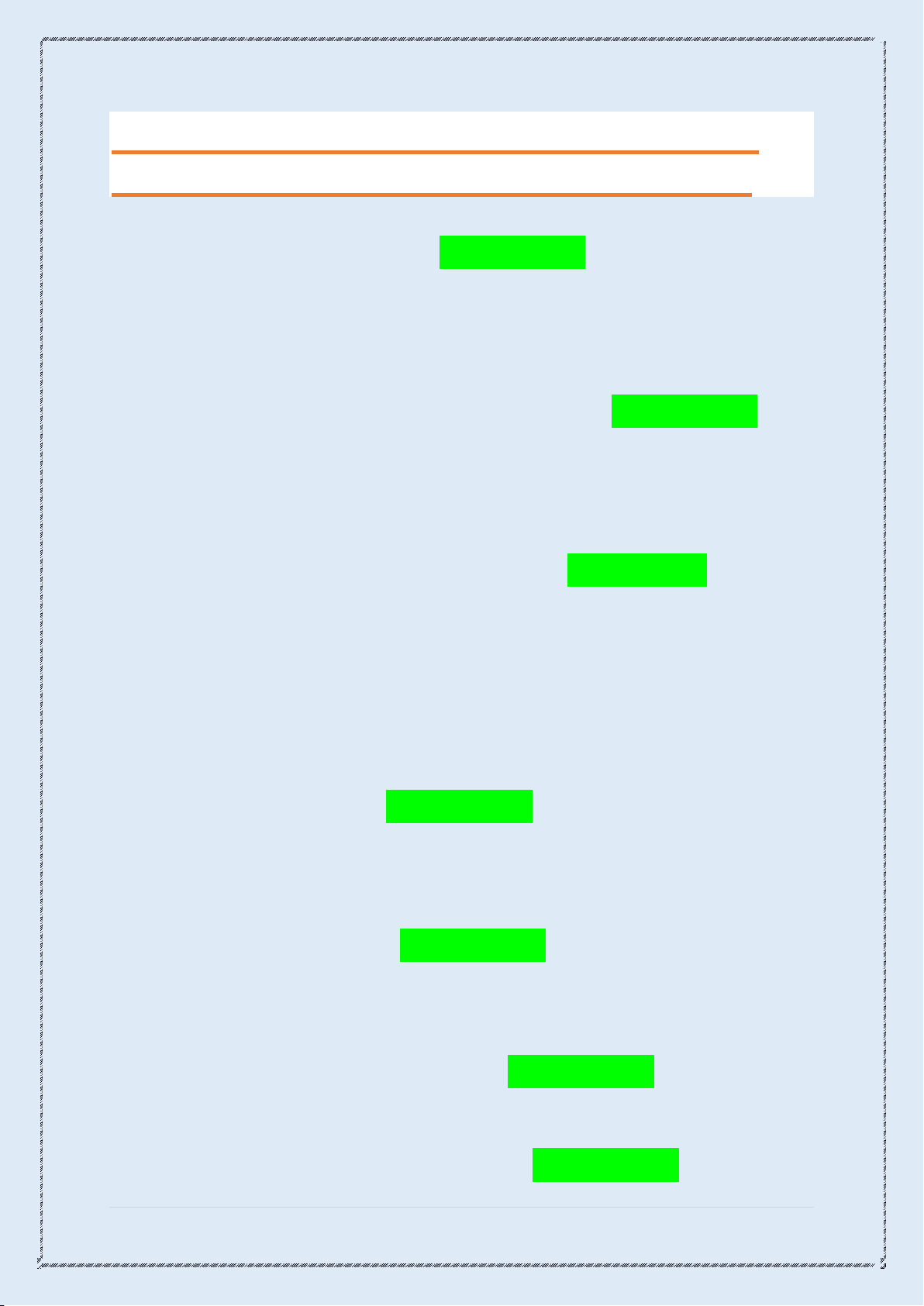
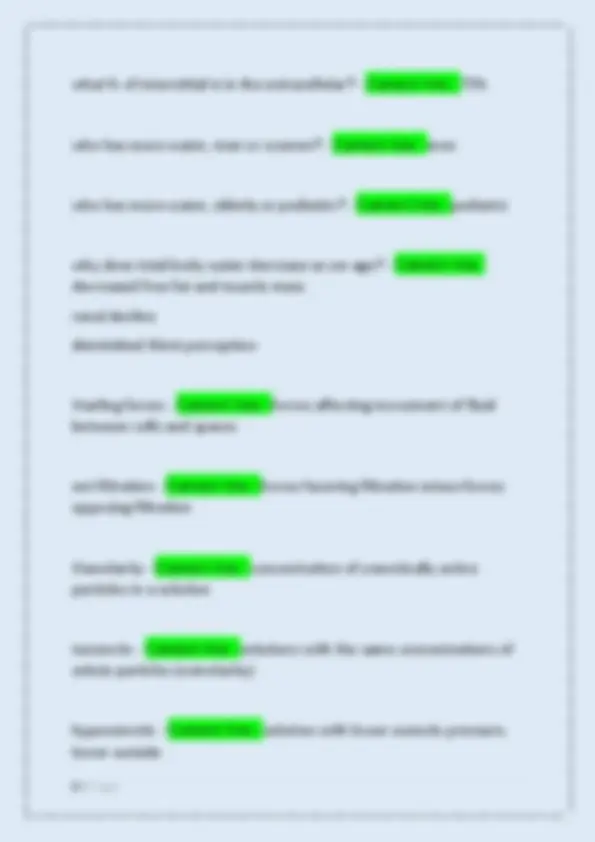
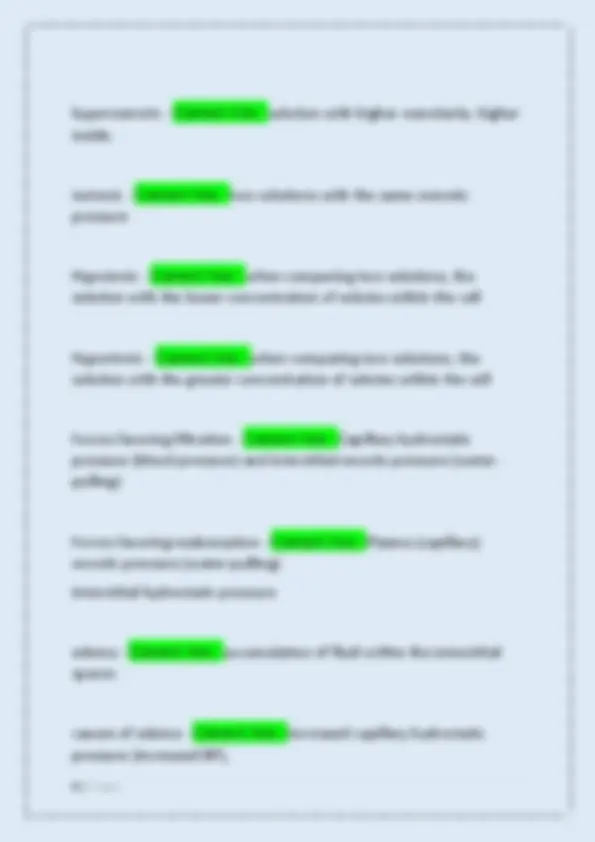
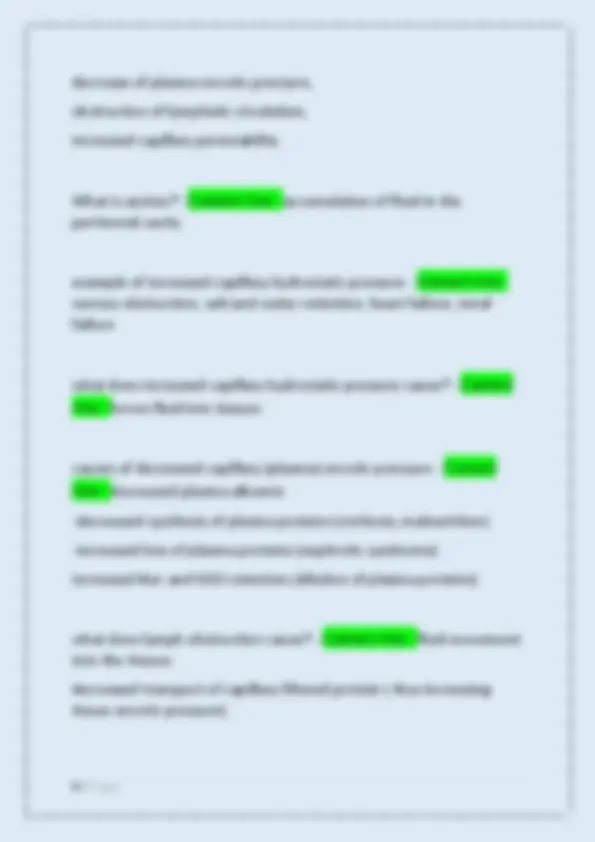
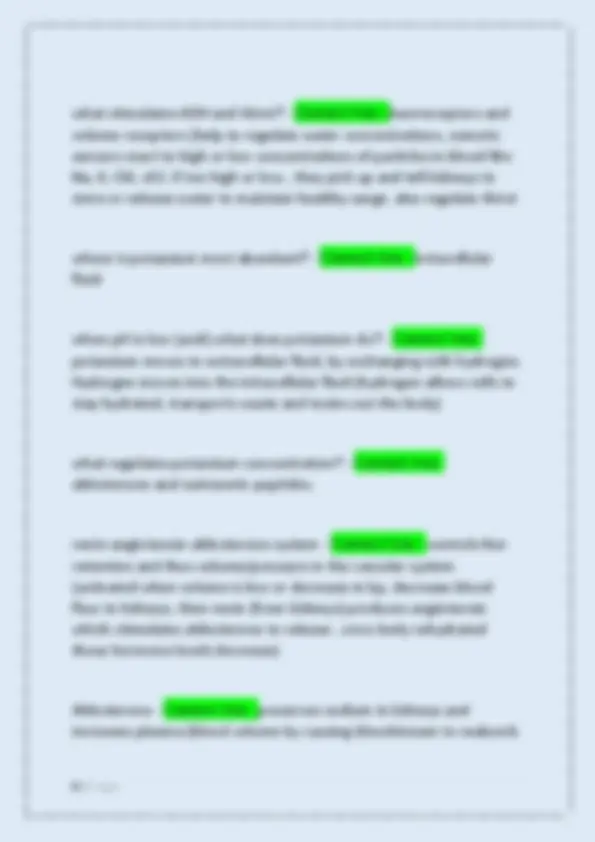
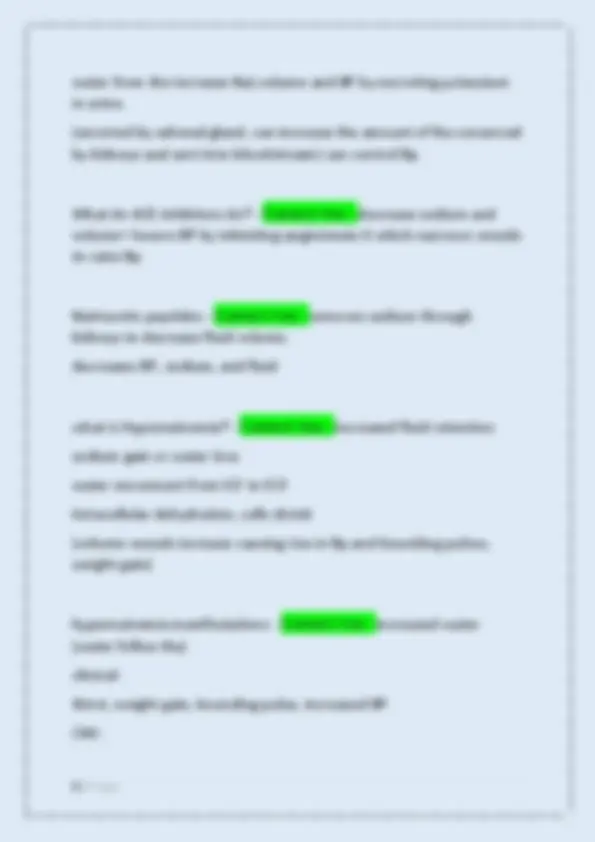
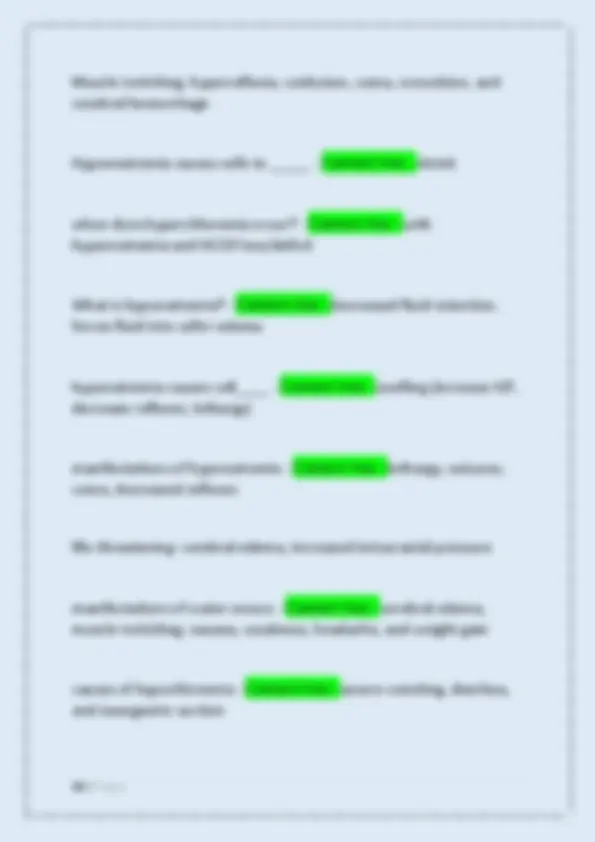
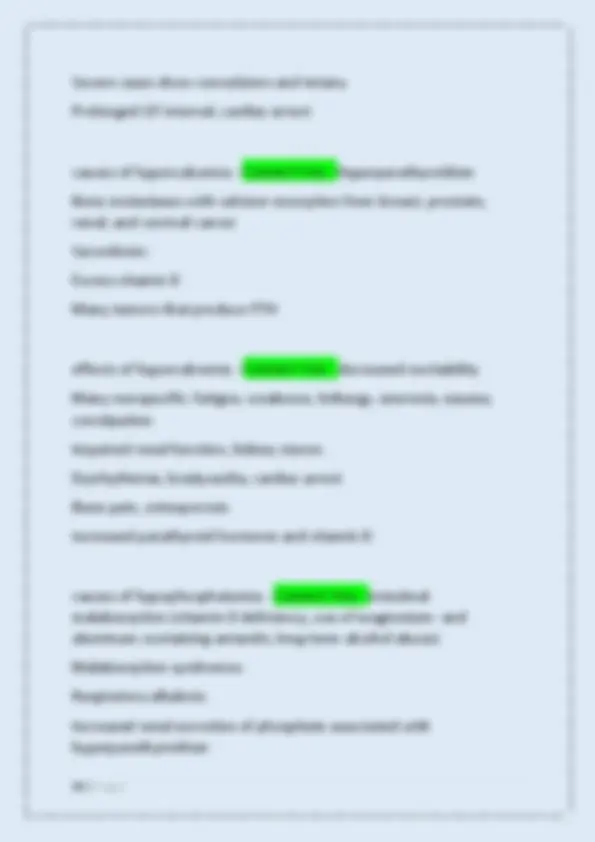
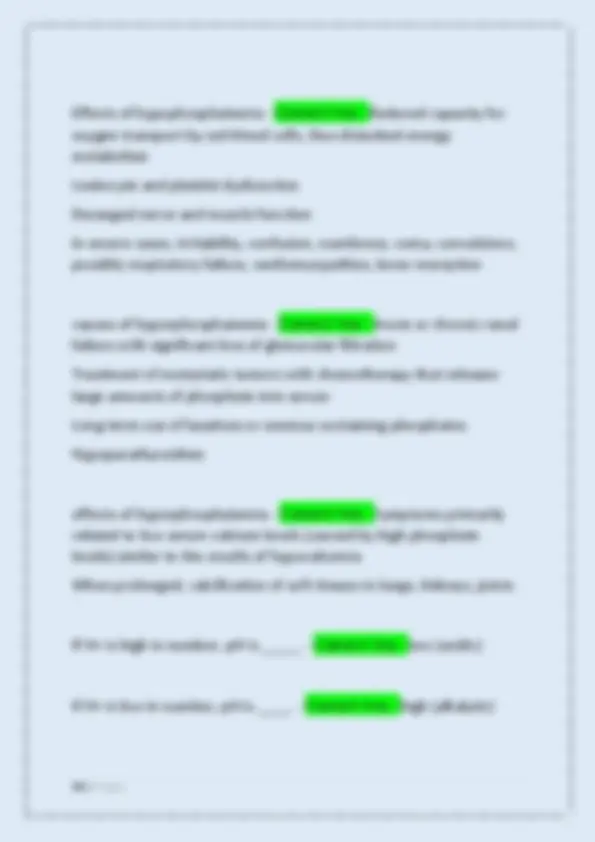
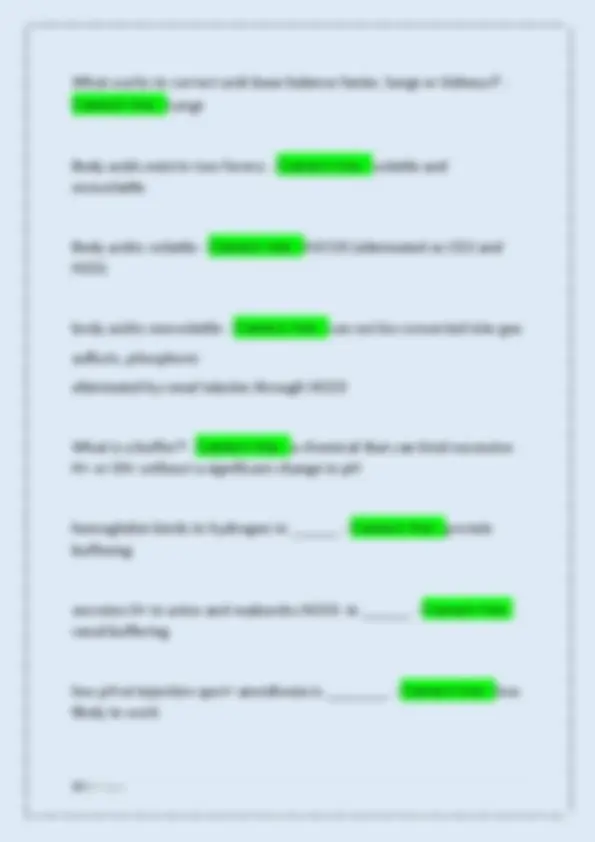
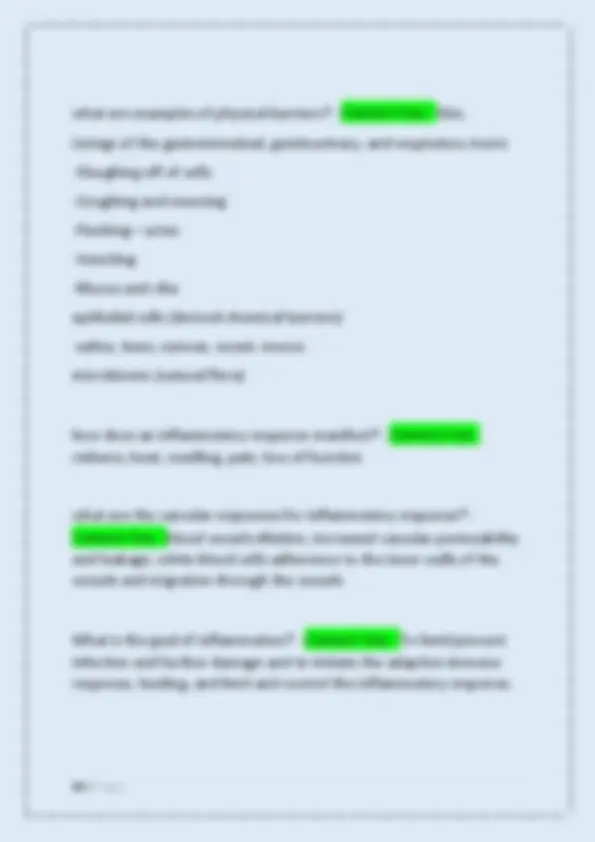
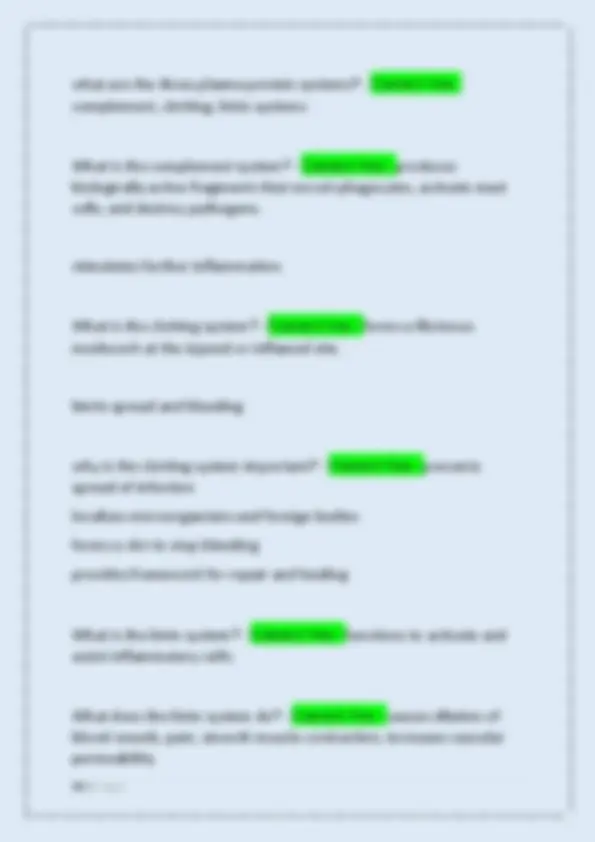
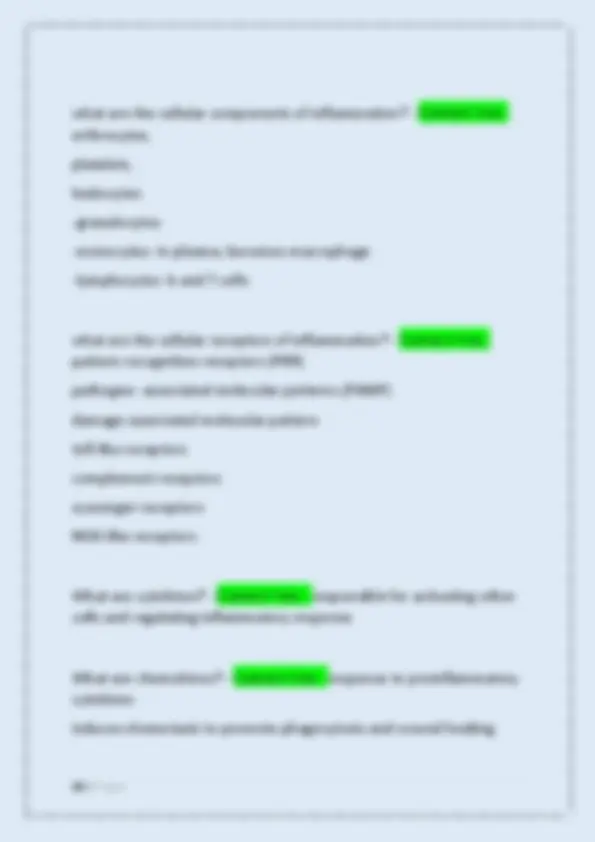
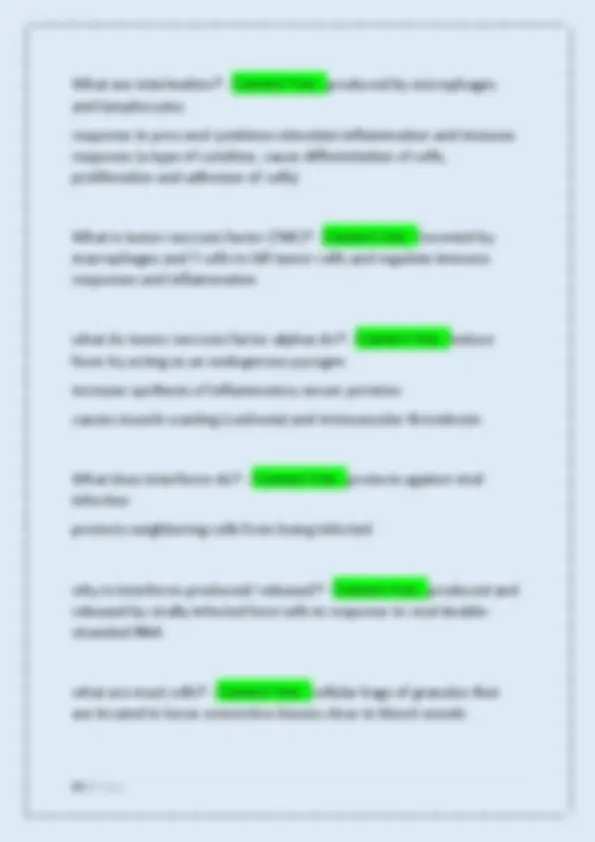
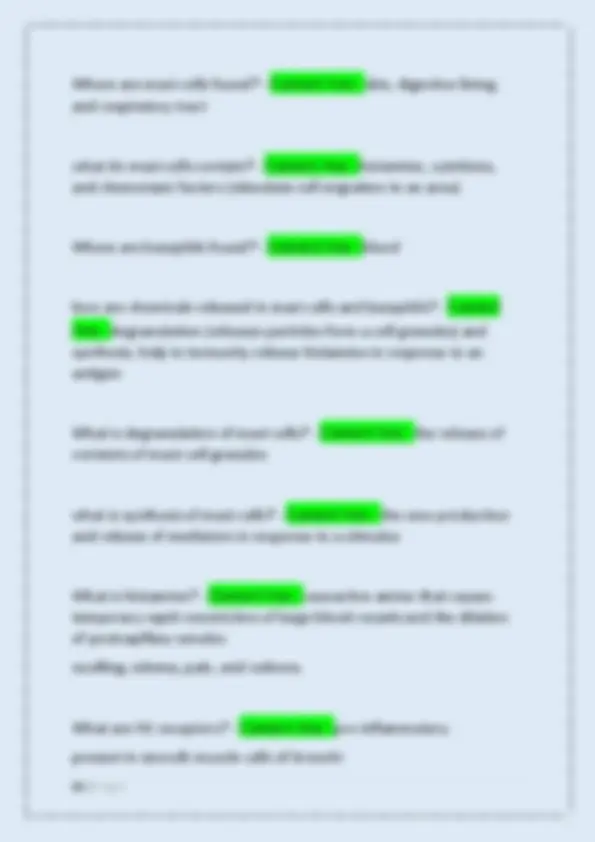

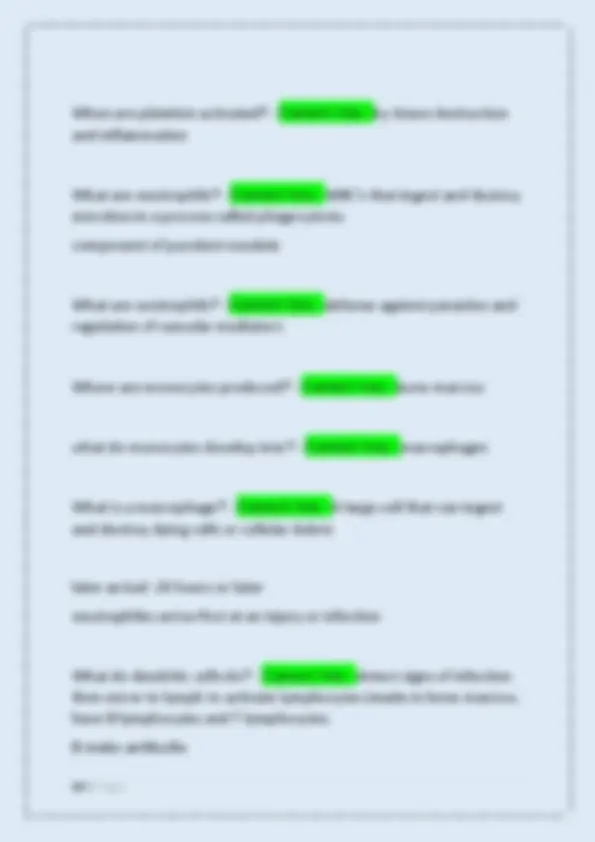
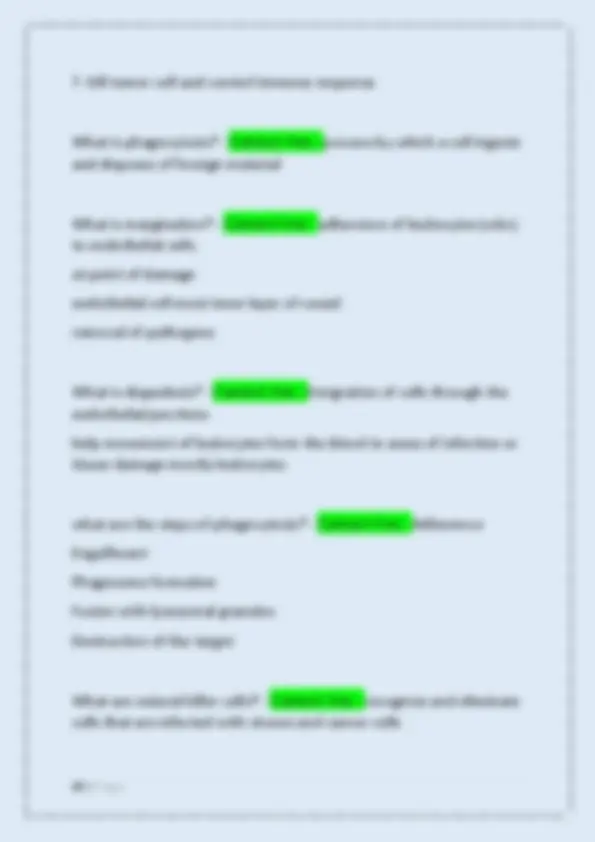



Study with the several resources on Docsity

Earn points by helping other students or get them with a premium plan


Prepare for your exams
Study with the several resources on Docsity

Earn points to download
Earn points by helping other students or get them with a premium plan
Community
Ask the community for help and clear up your study doubts
Discover the best universities in your country according to Docsity users
Free resources
Download our free guides on studying techniques, anxiety management strategies, and thesis advice from Docsity tutors
A comprehensive set of 160 questions and answers covering key concepts in epidemiology studies. It delves into topics such as chronic inflammation, adaptive immunity, fluid balance, electrolytes, and hormonal regulation. Designed to help students prepare for a quiz or exam in a biology course focusing on epidemiology.
Typology: Exams
1 / 26

This page cannot be seen from the preview
Don't miss anything!



















What is chronic inflammation? - Correct Ans : Inflammation that last from 2 weeks to months to years; It is often related to an unsuccessful acute inflammatory response.
What is chronic inflammation characterized by? - Correct Ans : pus formation, suppuration (purulent drainage), and incomplete wound healing
What is the purpose of adaptive immunity? - Correct Ans : Destruction of infectious microorganisms that are resistant to inflammation
Long-term highly effective protection against future exposure to the same microorganism
What is active immunity? - Correct Ans : exposure to antigen
immunizations
What is passive immunity? - Correct Ans : preformed antibodies or T cells are administered, mothers breast milk
what is a primary immunodeficiency? - Correct Ans : congenital
what is a secondary immunodeficiency? - Correct Ans : acquired
caused by another illness
more common
How is AIDS diagnosed? - Correct Ans : 1) positive evidence of HIV infection, 2) with an opportunistic infection, and 3) CD4 cell count less than 200 (discussed below).
Autoimmunity - Correct Ans : reaction of immune response to one's own tissues
Alloimmunity - Correct Ans : Immune reaction to tissues of another individual
water makes up ____% in men - Correct Ans : 60%
water makes up ____% in women - Correct Ans : 50%
made up of 2/3 (40%) of water - Correct Ans : intracellular
made up of 1/3 (20%) of water - Correct Ans : extracellular
what two things make up extracellular fluid? - Correct Ans : Intravascular and interstitial
what % of intravascular is in the extracellular? - Correct Ans : 25%
hyperosmotic - Correct Ans : solution with higher osmolarity. higher inside.
isotonic - Correct Ans : two solutions with the same osmotic pressure
Hypotonic - Correct Ans : when comparing two solutions, the solution with the lesser concentration of solutes within the cell
Hypertonic - Correct Ans : when comparing two solutions, the solution with the greater concentration of solutes within the cell
Forces favoring filtration - Correct Ans : Capillary hydrostatic pressure (blood pressure) and interstitial oncotic pressure (water- pulling)
Forces favoring reabsorption - Correct Ans : Plasma (capillary) oncotic pressure (water-pulling)
Interstitial hydrostatic pressure
edema - Correct Ans : accumulation of fluid within the interstitial spaces
causes of edema - Correct Ans : increased capillary hydrostatic pressure (increased BP),
decrease of plasma oncotic pressure,
obstruction of lymphatic circulation,
increased capillary permeability
What is ascites? - Correct Ans : accumulation of fluid in the peritoneal cavity
example of increased capillary hydrostatic pressure - Correct Ans : venous obstruction, salt and water retention, heart failure, renal failure
what does increased capillary hydrostatic pressure cause? - Correct
Ans : forces fluid into tissues
causes of decreased capillary (plasma) oncotic pressure - Correct
Ans : decreased plasma albumin
-decreased synthesis of plasma proteins (cirrhosis, malnutrition)
-increased loss of plasma proteins (nephrotic syndrome)
increased Na+ and H2O retention (dilution of plasma proteins)
what does lymph obstruction cause? - Correct Ans : fluid movement into the tissues
decreased transport of capillary filtered protein ( thus increasing tissue oncotic pressure)
what if sodium goes in the cell what does the chloride do? - Correct
Ans : follows it in.
what is the amount of sodium in the extracellular fluid? - Correct
Ans : 142
what is the amount of sodium in the intracellular fluid? - Correct
Ans : 12
what is the amount of chloride in the intracellular fluid? - Correct
Ans : 4
what is the amount of chloride in the extracellular? - Correct Ans : 103
antidiuretic hormone (ADH) - Correct Ans : promotes retention of water by kidneys
increases thirst
decreases urine
(made by hypothalamus and stored in post. pituitary gland)
(tells kidneys how much water to conserve, regulates water in the blood)
increased plasma= ______ water or _____ sodium - Correct Ans : decreased; increase
what stimulates ADH and thirst? - Correct Ans : baroreceptors and volume receptors (help to regulate water concentrations, osmotic sensors react to high or low concentrations of particles in blood like Na, K, Chl, c02. if too high or low , they pick up and tell kidneys to store or release water to maintain healthy range. also regulate thirst
where is potassium most abundant? - Correct Ans : intracellular fluid
when pH is low (acid) what does potassium do? - Correct Ans : potassium moves to extracellular fluid, by exchanging with hydrogen. Hydrogen moves into the intracellular fluid (hydrogen allows cells to stay hydrated, transports waste and toxins out the body)
what regulates potassium concentration? - Correct Ans : aldosterone and natriuretic peptides.
renin-angiotensin-aldosterone system - Correct Ans : controls Na+ retention and thus volume/pressure in the vascular system (activated when volume is low or decrease in bp, decrease blood flow to kidneys, then renin (from kidneys) produces angiotensin which stimulates aldosterone to release , once body rehydrated these hormone levels decrease)
Aldosterone - Correct Ans : preserves sodium in kidneys and increases plasma (blood volume by causing bloodstream to reabsorb
Muscle twitching, hyperreflexia, confusion, coma, convulsion, and cerebral hemorrhage
Hypernatremia causes cells to _____ - Correct Ans : shrink
when does hyperchloremia occur? - Correct Ans : with hypernatremia and HCO3 loss/deficit
What is hyponatremia? - Correct Ans : decreased fluid retention. forces fluid into cells= edema
hyponatremia causes cell____ - Correct Ans : swelling (increase ICP, decrease reflexes, lethargy)
manifestations of hyponatremia - Correct Ans : lethargy, seizures, coma, decreased reflexes
life-threatening- cerebral edema, increased intracranial pressure
manifestations of water excess - Correct Ans : cerebral edema, muscle twitching, nausea, weakness, headache, and weight gain
causes of hypochloremia - Correct Ans : severe vomiting, diarrhea, and nasogastric suction
Causes of hypokalemia - Correct Ans : reduced intake of potassium, increased entry of potassium into cells, and increased loss of potassium, low insulin
insulins stimulates ______ potassium in cells - Correct Ans : increased
Ketoacidosis= K+ is _____ of the cell - Correct Ans : outside. body thinks that it has too much K+ and pees it out
ketoacidosis= H+ is _____ of the cell - Correct Ans : inside
amount of potassium in the extracellular fluid? - Correct Ans : 5
amount of potassium of intracellular fluid? - Correct Ans : 150
Manifestations of hypokalemia - Correct Ans : Membrane hyperpolarization causes a decrease in neuromuscular excitability, skeletal muscle weakness, smooth muscle atony, and cardiac dysrhythmias
constipation, ileas, vomiting
Hypokalemia EKG - Correct Ans : T waves flatten; U waves more apparent
Severe cases show convulsions and tetany
Prolonged QT interval, cardiac arrest
causes of hypercalcemia - Correct Ans : Hyperparathyroidism
Bone metastases with calcium resorption from breast, prostate, renal, and cervical cancer
Sarcoidosis-
Excess vitamin D
Many tumors that produce PTH
effects of hypercalcemia - Correct Ans : decreased excitability
Many nonspecific: fatigue, weakness, lethargy, anorexia, nausea, constipation
Impaired renal function, kidney stones
Dysrhythmias, bradycardia, cardiac arrest
Bone pain, osteoporosis
increased parathyroid hormone and vitamin D
causes of hypophosphatemia - Correct Ans : Intestinal malabsorption (vitamin D deficiency, use of magnesium- and aluminum-containing antacids, long-term alcohol abuse)
Malabsorption syndromes
Respiratory alkalosis
Increased renal excretion of phosphate associated with hyperparathyroidism
Effects of hypophosphatemia - Correct Ans : Reduced capacity for oxygen transport by red blood cells, thus disturbed energy metabolism
Leukocyte and platelet dysfunction
Deranged nerve and muscle function
In severe cases, irritability, confusion, numbness, coma, convulsions, possibly respiratory failure, cardiomyopathies, bone resorption
causes of hyperphosphatemia - Correct Ans : Acute or chronic renal failure with significant loss of glomerular filtration
Treatment of metastatic tumors with chemotherapy that releases large amounts of phosphate into serum
Long-term use of laxatives or enemas containing phosphates
Hypoparathyroidism
effects of hyperphosphatemia - Correct Ans : Symptoms primarily related to low serum calcium levels (caused by high phosphate levels) similar to the results of hypocalcemia
When prolonged, calcification of soft tissues in lungs, kidneys, joints
If H+ is high in number, pH is _____ - Correct Ans : low (acidic)
If H+ is low in number, pH is ____. - Correct Ans : high (alkalytic)
carbonic acid-bicarbonate buffer system - Correct Ans : chemical system that helps maintain pH homeostasis of the blood
what are the major organs involved in the regulation of acid-base
balance? - Correct Ans : bones, lungs, and kidneys
Carbonic acid can be broken down into what? - Correct Ans : CO (carbon dioxide) and H2O (Water) or H+(hydrogen) and HCO3- (bicarbonate)
where does carbonic acid operate? - Correct Ans : kidneys and lungs
what is the ratio of bicarbonate to carbonic acid in a neutral pH? -
Correct Ans : 20:1 (Ratio must be maintained even with increases and decreases)
how does respiratory compensate? - Correct Ans : Increase ventilation= expire CO2 (decrease in CO2)
Decrease ventilation= retain CO2 (Increase or stay the same CO2)
How do the kidneys compensate? - Correct Ans : make urine more acidic or alkaline
In acidosis the body ______ H+ and _____ HCO3-bicarbonate (Base) -
Correct Ans : Increases, decreases,
In alkalosis the body ______ H+ and ______ HCO3- Bicarbonate
(Base) - Correct Ans : Decreases, increases
respiratory acidosis - Correct Ans : elevation of pCO2 as a result of ventilation depression
respiratory alkalosis - Correct Ans : depression of pCO2 as a result of alveolar hyperventilation
metabolic acidosis - Correct Ans : depression of HCO3- or an increase in noncarbonic acids
metabolic alkalosis - Correct Ans : elevation of HCO3- usually caused by an excessive loss of metabolic acids
what is the first line of defense called? - Correct Ans : Innate immunity ( natural/native)
What is innate immunity? - Correct Ans : Physical and chemical barrier to keep out pathogens
What is the second line of defense? - Correct Ans : inflammation
What is the third line of defense? - Correct Ans : adaptive immunity (acquired/ specific)
what are the three plasma protein systems? - Correct Ans : complement, clotting, kinin systems
What is the complement system? - Correct Ans : produces biologically active fragments that recruit phagocytes, activate mast cells, and destroy pathogens.
stimulates further inflammation.
What is the clotting system? - Correct Ans : forms a fibrinous meshwork at the injured or inflamed site.
limits spread and bleeding
why is the clotting system important? - Correct Ans : prevents spread of infection
localizes microorganisms and foreign bodies
forms a clot to stop bleeding
provides framework for repair and healing
What is the kinin system? - Correct Ans : functions to activate and assist inflammatory cells.
What does the kinin system do? - Correct Ans : causes dilation of blood vessels, pain, smooth muscle contraction, increases vascular permeability
what are the cellular components of inflammation? - Correct Ans : erthrocytes,
platelets,
leukocytes
-granulocytes
-monocytes- in plasma, becomes macrophage
-lymphocytes- b and T cells
what are the cellular receptors of inflammation? - Correct Ans : pattern recognition receptors (PRR)
pathogen- associated molecular patterns (PAMP)
damage-associated molecular pattern
toll-like receptors
complement receptors
scavenger receptors
NOD-like receptors
What are cytokines? - Correct Ans : responsible for activating other cells and regulating inflammatory response
What are chemokines? - Correct Ans : response to proinflammatory cytokines
induces chemotaxis to promote phagocytosis and wound healing.